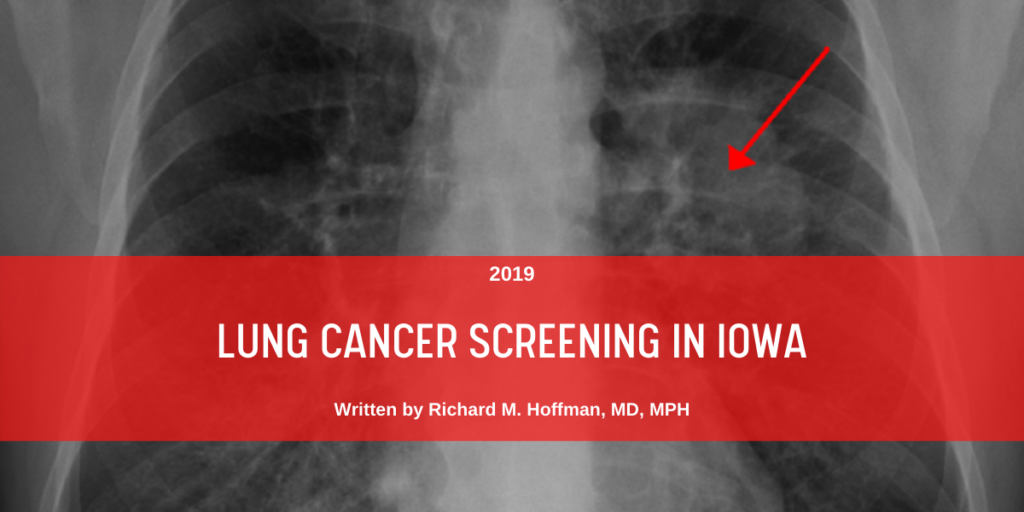Lung Cancer Screening in Iowa

Written by:
Richard M. Hoffman, MD, MPH
Professor of Internal Medicine and Epidemiology
Director, Division of General Internal Medicine
University of Iowa Carver College of Medicine/Iowa City VA Medical Center
Lung cancer screening generated considerable national attention when the National Lung Screening Trial published results in 2011, showing that screening with low-dose CT (LDCT) scans reduced lung cancer mortality by 20% compared to screening with chest x-rays. Numerous professional societies and organizations, including the US Preventive Services Task Force, began recommending LDCT screening for heavy smokers ages 55 to 80. However, all guidelines also recommended informing patients about the potential harms of screening, which included high rates of false positive tests, radiation exposure, incidental findings, overdiagnosis, and potential complications from invasive diagnostic procedures. The Centers for Medicare & Medicaid Services (CMS) took the unprecedented step of requiring that clinicians first conduct (and document) the occurrence of a shared decision-making (SDM) counseling visit using a decision aid before they would reimburse screening. CMS also requires that programs address tobacco control and submit data to national registry run by the American College of Radiology (ACR).
The American Cancer Society has convened the National Lung Cancer Roundtable (NLCRT) to address screening implementation. The most recent meeting, held in December 2018, focused on a number of issues, including the low uptake of screening (https://nlcrt.org/event/2018-nlcrt-annual-meeting/). The National Health and Nutrition Examination Survey reported that in 2015 only 5.8% of high-risk American smokers had undergone an LDCT screening exam. Important barriers to effective screening include providers struggling to conduct high-quality shared decision-making visits, the patchy availability of certified lung cancer screening centers, the challenges of using medical records to accurately identify eligible smokers, lack of patient awareness about screening, limited insurance coverage for diagnostic procedures and treatment, and the stigma over tobacco use that sometimes prevents providers from offering and patients from accepting LDCT.
Achieving SDM has been particularly challenging. Clinicians often lack the time, content expertise, and training to conduct these discussions. One approach has been to centralize the decision making to take the discussions out of primary care. In this model, clinicians determine whether a person is eligible for screening (based on smoking history and being healthy enough to be considered for lung surgery), provide a decision aid, and then refer the person to meet with a licensed independent practitioner (a CME expectation) who has been trained to conduct the SDM visit. The SDM subcommittee of the NLCRT, of which I’m a member, is investigating strategies to train providers in SDM and evaluate the quality of decision making. We are also exploring conducting decision-making “visits” through telemedicine (acceptable to CMS).
Representatives from a number of states, including Georgia, Kentucky, West Virginia, and Massachusetts, described state-wide initiatives to promote screening. Common themes included provider engagement and education, increasing public awareness, enhancing access and navigation for screening and care, establishing quality metrics, addressing policy issues, and supporting tobacco control efforts. In Iowa, there are currently 32 registered screening sites contributing to the ACR registry and they have conducted 1,412 screening tests. However, there is no concerted statewide effort addressing the educational and implementation issues identified by other states at the NLCRT.
Lung cancer is an important public health burden for Iowa, being the 2nd most frequently diagnosed cancer and the leading of cancer death. Creating a statewide coalition could have important public health benefits. The Iowa Cancer Consortium does have a lung cancer screening workgroup, but we’ve not been very active. The committee could take the lead in working with cancer control leaders throughout the state in identifying barriers and facilitators for implementing high-quality screening and linked tobacco control programs. I encourage the committee members to begin thinking about ways to address lung cancer screening in Iowa and invite other interested Consortium members to join us.
